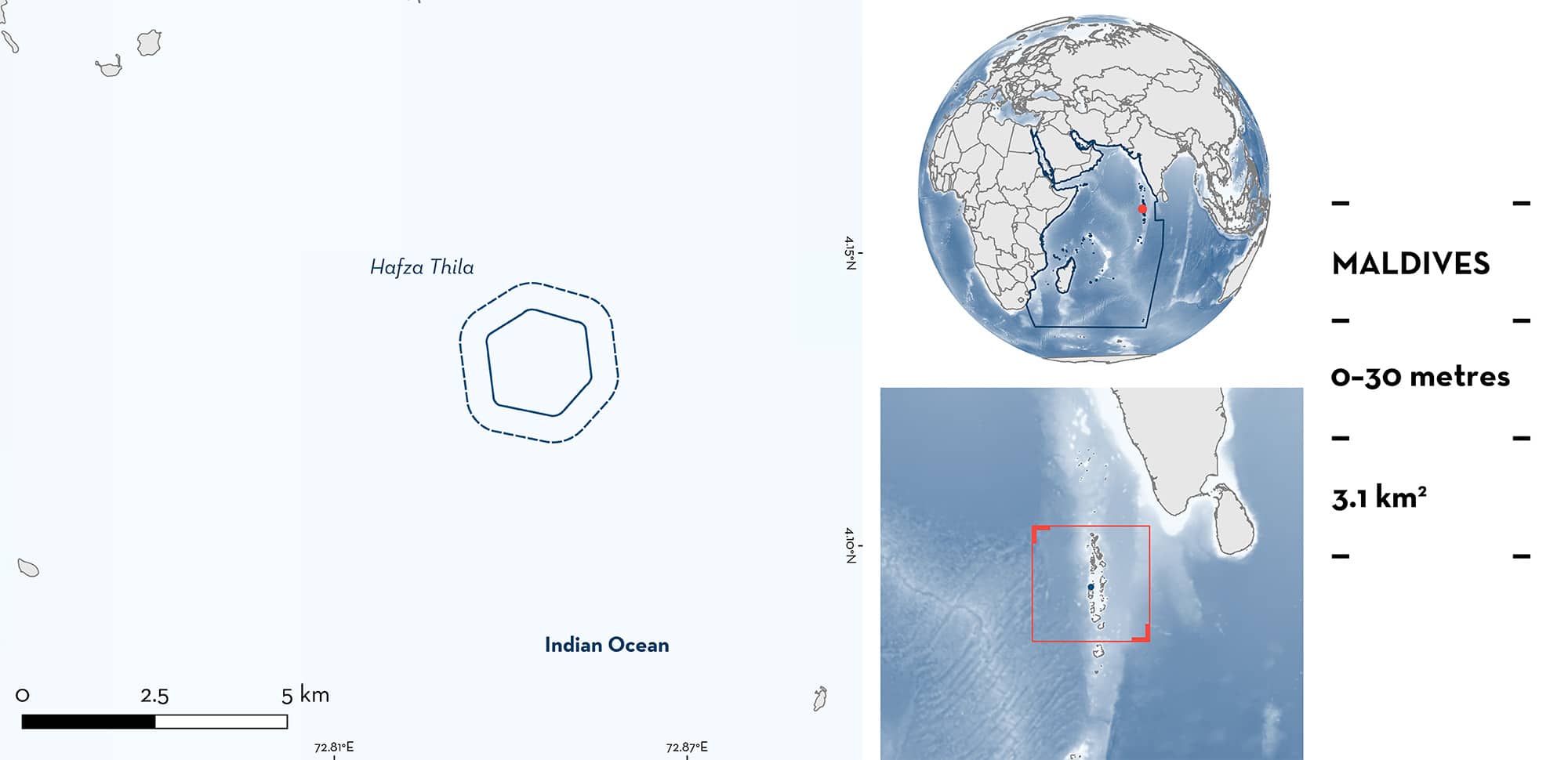ISRA FACTSHEETS
ISRA FACTSHEETS
WESTERN INDIAN OCEAN REGION
Hafza Thila
Summary
Hafza Thila is located in the North Ari Atoll in the northern-central Maldives. This area is composed of an oval shaped pinnacle reef in the middle of the atoll. The top reef is completely submerged with a depth of 10–12 m and slopes down to 35 m reaching a sandy bottom. The reef wall has several overhangs and black corals at varying depths. Within this area there are: threatened species and undefined aggregations (Grey Reef Shark Carcharhinus amblyrhynchos).
Download factsheet
Hafza Thila
DESCRIPTION OF HABITAT
Hafza Thila is located in the northern-central Maldives archipelago which sits centrally upon the Chagos-Laccadive Ridge (Stevens & Froman 2019). This area is an oval pinnacle reef in the middle of the atoll basin of the North Ari Atoll. Thila is the local name for underwater pinnacle reef where the top of the reef is completely submerged, even during low tide (Stevens & Froman 2019). The top reef has a depth of 10–12 m and slopes down to 35 m reaching a sandy bottom. This area has several vertical walls at varying depths with overhangs and black corals surrounding the thila.
The weather in the Maldives is strongly influenced by the South Asian monsoon, especially the northern and central atolls as these are closer to the Indian subcontinent (Anderson et al. 2011). Therefore, two monsoons occur annually in Maldives. The southwest monsoon (locally known as Hulhan’gu), from May to November, and the northeast monsoon (locally known as Iruvai), from January to March, with transitional periods in December and April (Shankar et al. 2002; Anderson et al. 2011). The southwest monsoon increases average rainfall, and wind speeds, causing rougher seas and reduced visibility; in contrast, the northeast monsoon usually brings clear waters (Stevens & Froman 2019).
The Maldives archipelago disrupts the flow of the monsoon-driven North Equatorial Current as it crosses the Indian Ocean (Schott & McCreary 2001) which creates a current flow through the Maldives’ channels (Sasamal 2006). The strongest lunar currents can overcome the prevailing monsoonal currents through the tidal suction mechanism along the channel’s outer edges (Stevens 2016).
This Important Shark and Ray Area is benthopelagic and is delineated from inshore and surface waters (0 m) to a depth of 30 m based on the depth range of Qualifying Species in this area.
CRITERION A
VULNERABILITY
The one Qualifying Species occurring in the area is considered threatened with extinction according to the IUCN Red List of Threatened SpeciesTM. The Grey Reef Shark is assessed as Endangered (Simpfendorfer et al. 2020).
CRITERION C
SUB-CRITERION C5 – UNDEFINED AGGREGATIONS
Hafza Thila is an important area for undefined aggregations of one shark species.
Data were collected from a citizen-science program known as the Sharkwatch project which was a government-led initiative between 2009–2019 (Maldives Marine Research Institute [MMRI] unpubl. data 2023). Data were collected by experienced dive guides using the roving diver technique where surveyors can swim in any direction and count the number of individuals encountered by species during one-hour dive survey.
From the ~1,110 sites surveyed in the Maldives, this area has been identified as an important aggregation for the Grey Reef Shark (MMRI unpubl. data 2023). Sharkwatch surveys were conducted over seven years (2011–2017; n = 108) in this area (MMRI unpubl. data 2023). During this period, Grey Reef Shark showed a mean encounter rate of 5 sharks/hour (MMRI unpubl. data 2023). The highest encounters per survey were recorded in 2015 and 2017 with 31 Grey Reef Sharks/hour recorded each year (MMRI unpubl. data 2023). Aggregations of 15 Grey Reef Sharks in average are frequently observed on one side (up current) of the reef pinnacle in which a maximum of 30 individuals have been recorded aggregating (G Stevens pers. obs. 2023; A Khalid pers. obs. 2023). This area might function as a nursery area as small individuals, probably neonates and young-of-the year, are usually observed (G Stevens pers. obs. 2023; A Khalid pers. obs. 2023). Further information is needed to determine the regular and predictable use of this area and its potential importance for reproductive purposes.
Download factsheet
SUBMIT A REQUEST
ISRA SPATIAL LAYER REQUEST
To make a request to download the ISRA Layer in either a GIS compatible Shapefile (.shp) or Google Earth compatible Keyhole Markup Language Zipped file (.kmz) please complete the following form. We will review your request and send the download details to you. We will endeavor to send you the requested files as soon as we can. However, please note that this is not an automated process, and before requests are responded to, they undergo internal review and authorization. As such, requests normally take 5–10 working days to process.
Should you have questions about the data or process, please do not hesitate to contact us.


